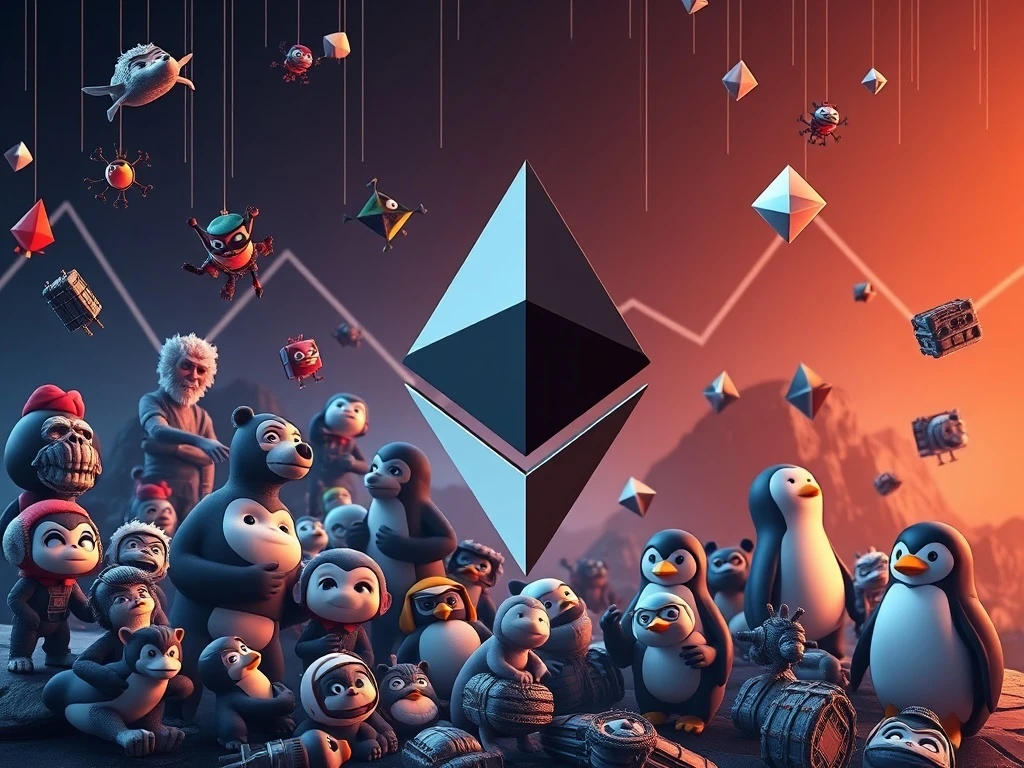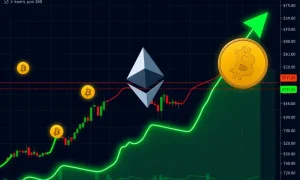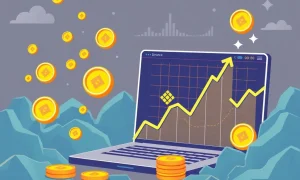For entrepreneurs and investors in the digital asset space, understanding market shifts is crucial. Recently, the **NFT market cap** experienced a significant downturn. This sharp decline wiped out over $1.2 billion in value. It highlights the volatile nature of non-fungible tokens and their deep connection to broader cryptocurrency trends, particularly the price movements of Ether. This event serves as a stark reminder for those navigating the fast-paced world of digital collectibles.
NFT Market Cap Sees Significant Contraction
The non-fungible token (NFT) market recently faced a notable financial setback. Its total valuation plummeted by more than $1.2 billion in under a week. This substantial drop occurred as Ether’s (ETH) rally lost momentum. According to NFT Price Floor data from Monday, the total valuation of NFT collections fell to $8.1 billion. This figure represents a 12% decline from the previous Wednesday’s market cap of $9.3 billion. Previously, the market had seen a strong 40% surge since July.
This rapid depreciation in the **NFT market cap** underscores the sector’s inherent sensitivity. Such large-scale value shifts can significantly impact digital asset portfolios. Investors and collectors alike closely monitor these trends. Understanding the underlying causes of such movements is essential for making informed decisions. The recent dip suggests a period of adjustment for the entire NFT ecosystem.
Ether’s Pivotal Role in NFT Market Cap Dynamics
The decline in the **NFT market cap** directly coincided with a 9% drop in Ether (ETH) prices. Ether is the native cryptocurrency of the Ethereum network. At the time of writing, StockPil data indicated ETH traded at $4,260. This was down from a high of approximately $4,700 just days earlier. Most NFTs are minted on the Ethereum blockchain. Consequently, their valuations and sales are often denominated in ETH. Therefore, bullish or bearish momentum in Ether frequently translates into corresponding value changes within the NFT sector. A 4% decrease in ETH over 24 hours mirrored declines across a majority of the top 10 NFT collections. This correlation emphasizes Ether’s critical influence on NFT valuations.
The interconnectedness between ETH and NFTs is fundamental. It means that the health of the Ethereum network and the stability of its native token directly affect the broader NFT economy. Investors must consider Ether’s performance when assessing NFT investments. Furthermore, this relationship highlights the foundational role of blockchain infrastructure in supporting digital asset markets. Any significant price action in ETH can create ripple effects throughout the NFT landscape, impacting investor confidence and trading volumes. This close link is a defining characteristic of the current NFT market structure.
Divergent Paths Among Top NFT Collections
While the overall **NFT market cap** experienced a downturn, individual collections reacted differently. Some saw significant losses, while others demonstrated relative resilience or even climbed the ranks. This varied performance offers insights into the maturity and perceived value of different digital assets.
CryptoPunks: A Bellwether for NFT Market Cap Shifts
CryptoPunks maintained its position as the top collection by market capitalization. However, it still saw a substantial decline. Approximately $300 million was wiped from the collection’s value. Data showed its worth at $2.1 billion on Monday. This represented a 12% drop from its $2.4 billion market cap on Wednesday. Moreover, CryptoSlam data indicated a significant reduction in activity. The collection’s sales volume reached only $12.7 million, marking a 34% drop in the last seven days. Total sales also fell to 51, a 28% decrease in the past week. These figures highlight the widespread impact of the market correction, even on established blue-chip NFTs.
CryptoPunks have historically been a benchmark for the NFT market. Their performance often signals broader trends. The considerable reduction in their market cap and sales volume suggests a period of consolidation. This also reflects increased caution among high-value collectors. Despite the drop, their continued top ranking underscores their enduring status. They remain a foundational pillar in the digital art and collectible space. However, even titans are not immune to market forces.
Bored Ape Yacht Club’s Position in the NFT Market Cap Hierarchy
The Bored Ape Yacht Club (BAYC), previously ranked second in overall **NFT market cap**, slipped to third place on Monday. The collection’s valuation declined to $482.3 million. This marked an almost 20% drop from its $602 million valuation on Wednesday. BAYC’s fall in ranking signifies a shift in the competitive landscape of top-tier NFT projects. Its decline reflects the broader market sentiment and the impact of Ether’s price drop. Many BAYC holders have substantial capital invested. Therefore, this decline directly affects a large segment of the NFT community.
The Bored Ape Yacht Club has long been synonymous with mainstream NFT adoption and celebrity interest. Its ecosystem includes various spin-off projects and a strong community. However, its recent performance indicates that even highly prominent collections are susceptible to market volatility. The shift in its ranking highlights the dynamic nature of market leadership. Furthermore, it suggests that investor focus may be diversifying among blue-chip assets. This underscores the need for continuous evaluation of NFT portfolios.
Pudgy Penguins Defy Trend in NFT Market Cap Rankings
Amidst the widespread market downturn, Pudgy Penguins emerged as a notable exception. This collection climbed to the second-highest valuation. Despite erasing approximately $100 million in overall value, its relative performance was strong. On Monday, the collection’s market cap stood at $491 million. This was down 17% from Wednesday’s $591 million. Pudgy Penguins overtook BAYC, a significant achievement in a declining market. This rise indicates a shift in investor preference or perceived stability within the blue-chip NFT space.
Last week, publicly traded blockchain company BTCS Inc. announced a strategic move. They added three Pudgy Penguins NFTs to their corporate digital asset treasury. This action is highly significant. It signals that companies are increasingly recognizing blue-chip NFT collections as legitimate assets for treasury diversification. Such institutional adoption lends credibility and long-term potential to these digital collectibles. It also distinguishes them from more speculative projects. The decision by BTCS Inc. reinforces the idea that certain NFTs are evolving beyond mere collectibles into recognized financial instruments. This corporate endorsement likely contributed to Pudgy Penguins’ resilience and rise in ranking. It suggests a growing institutional confidence in select NFT projects, impacting their perceived value and stability within the broader **NFT market cap**.
Understanding Volatility in the NFT Market Cap
The recent fluctuations in the **NFT market cap** are not isolated incidents. They reflect the inherent volatility of nascent markets. Several factors contribute to these rapid changes. Firstly, the speculative nature of many NFT investments plays a significant role. Many buyers enter the market hoping for quick gains. This can lead to rapid price increases during bull runs and sharp declines during corrections. Secondly, the broader cryptocurrency market sentiment heavily influences NFTs. As demonstrated, a dip in Ether’s price directly impacts NFT valuations. Macroeconomic factors, such as inflation rates or interest rate changes, can also affect investor appetite for risk assets like NFTs.
Liquidity issues can also exacerbate market downturns. Unlike traditional assets, the NFT market can be less liquid. This means fewer buyers may be available when many sellers want to exit. This imbalance can lead to steeper price drops. However, blue-chip NFTs, like CryptoPunks or Pudgy Penguins, often exhibit more resilience. They benefit from established communities and a perceived higher intrinsic value. These assets may attract long-term holders. Such holders are less likely to panic sell during market corrections. Understanding these dynamics is crucial for anyone participating in the digital collectibles space. It helps to differentiate between short-term speculation and long-term investment potential.
The Future Outlook for the NFT Market Cap
Despite recent setbacks, the long-term outlook for the **NFT market cap** remains a topic of debate. The market is still relatively young. Its future trajectory will depend on several evolving factors. Increased utility beyond simple collectibles is one key driver. Projects offering real-world benefits or integration into gaming and metaverse ecosystems may see sustained growth. Furthermore, regulatory clarity will play a vital role. Clear guidelines could attract more institutional investors. This would bring greater stability and liquidity to the market.
Technological advancements also hold significant promise. Innovations in blockchain technology could reduce transaction costs and improve scalability. This would make NFTs more accessible to a wider audience. The ongoing development of new use cases, from digital identities to intellectual property management, could also fuel future expansion. Ultimately, the **NFT market cap** will likely mature over time. It may become less susceptible to extreme volatility as the market finds its footing. Investor education and a shift towards fundamental value rather than pure speculation will also contribute to its stability. The market’s ability to innovate and adapt will be crucial for its sustained growth.
In conclusion, the recent $1.2 billion drop in the **NFT market cap** underscores the profound influence of Ether’s performance on the digital collectibles space. While leading collections like CryptoPunks and Bored Ape Yacht Club faced significant declines, Pudgy Penguins demonstrated remarkable resilience, even ascending in rank. This event highlights the dynamic and often volatile nature of the NFT market, heavily intertwined with the broader cryptocurrency ecosystem. As the market continues to evolve, understanding these intricate relationships and the varying performance of individual collections will be paramount for participants. The future of NFTs will depend on innovation, increased utility, and the growing maturity of the digital asset landscape.
Frequently Asked Questions (FAQs)
Q1: Why did the NFT market cap drop significantly?
The NFT market cap dropped primarily due to a substantial decline in Ether (ETH) prices. Most NFTs are built on the Ethereum blockchain, and their valuations are closely tied to ETH’s value. When ETH falls, the value of NFTs denominated in ETH often follows suit, leading to an overall market cap reduction.
Q2: How does Ether’s price directly impact NFT values?
Ether’s price directly impacts NFT values because many NFTs are minted, bought, and sold using ETH. If ETH’s value decreases, the underlying currency for these transactions loses purchasing power, effectively lowering the dollar-denominated value of the NFTs. Furthermore, market sentiment around ETH can influence investor confidence in the broader Ethereum-based NFT ecosystem.
Q3: Why did Pudgy Penguins climb in rank despite the market downturn?
Pudgy Penguins climbed to second place in market capitalization despite the downturn due to a combination of factors. Its community likely showed stronger holding power, and notably, a publicly traded company, BTCS Inc., added Pudgy Penguins NFTs to its corporate treasury. This institutional adoption signals growing legitimacy and confidence in the collection, contributing to its relative resilience and rise in ranking.
Q4: What are “blue-chip” NFTs, and how do they perform in a market downturn?
“Blue-chip” NFTs refer to established, highly valued, and generally more reputable collections like CryptoPunks or Bored Ape Yacht Club. While they are not immune to market downturns, they often exhibit more resilience than newer or less established projects. They tend to have strong communities, historical significance, and a perceived higher intrinsic value, which can attract long-term holders and institutional interest.
Q5: What factors contribute to the volatility of the NFT market?
Several factors contribute to NFT market volatility. These include the speculative nature of many investments, the direct correlation with major cryptocurrency prices (especially Ether), broader macroeconomic trends affecting investor risk appetite, and sometimes lower liquidity compared to traditional asset markets. These elements can lead to rapid price swings in both directions.
Q6: What does the corporate adoption of NFTs like Pudgy Penguins signify for the market?
Corporate adoption of NFTs, such as BTCS Inc. adding Pudgy Penguins to its treasury, signifies a growing recognition of certain blue-chip NFT collections as legitimate digital assets. It suggests that companies are beginning to view them as viable for treasury diversification or strategic investments, moving beyond mere speculative collectibles. This trend can bring greater legitimacy, stability, and potentially new institutional capital to the NFT market.








